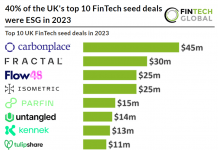Sustainable finance is becoming the linchpin for the EU in achieving its environmental and climate objectives. It achieves this by channeling funds into environmentally-conscious projects.
Hand in hand with this, sustainability reporting plays a pivotal role, especially in promoting transparency in various sectors including environmental, social, economic, and governance.
Greenomy, a developer of ESG and sustainability reporting software, recently explored the relationships between CSRD, EU Taxonomy and SFDR.
Such reporting is instrumental in helping organisations pinpoint risks and opportunities associated with sustainability. This approach paves the way for a resilient and future-proof business model and fosters meaningful dialogue with stakeholders. This dual method by the EU not only equips investors with vital information for informed decision-making but also puts corporations under a lens, curbing instances of greenwashing.
A significant aspect of the EU’s sustainable finance framework is the introduction of the EU Taxonomy, the Corporate Sustainability Reporting Directive (CSRD), and the Sustainable Finance Disclosure Regulation (SFDR). These interconnected regulations aim to steer investments towards Taxonomy-compliant activities and allow investors to identify them.
Decoding SFDR and its significance Introduced by the European Union, the Sustainable Finance Disclosure Regulation (SFDR) is primarily aimed at elevating transparency levels within sustainable investments. It requires Financial Market Participants (FMPs) and Financial Advisors (FAs) to disclose information concerning their environmental, social, and governance (ESG) activities at both the entity and product levels.
Come January 2023, there are added layers to the SFDR in the form of the Regulatory Technical Standards (RTS), offering a more granular guideline for compliance.
At its heart, the SFDR has two major objectives. Firstly, it is about redirecting capital into sustainable investment channels by giving investors transparent and uniform information. Secondly, it’s about checking the surge of greenwashing, ensuring investors are spared from misleading or overstated claims.
For the uninitiated, Financial Advisors, or FAs, encompass entities that offer advice on investment or insurance-based products. This not only includes entities functioning within the EU but also those that are looking to market their products to the EU audience. Similarly, Financial Market Participants (FMPs) are those entities engaged in the manufacturing and sale of financial products or providing asset management services, targeting the EU market.
Demystifying CSRD and its objectives Superseding its predecessor, the Non-Financial Reporting Directive (NFRD), the Corporate Sustainability Reporting Directive (CSRD) became the EU’s latest legislative tool on January 5, 2023.
CSRD’s objective is multifaceted. It is set to usher in standardisation in ESG disclosures, thus bridging information gaps. This, in turn, will aid stakeholders, be it investors or regulators, in evaluating and contrasting the sustainability performance of varied companies. By mandating extensive disclosures, it aims to shed more light on corporate ESG actions, facilitating informed decision-making. Moreover, CSRD isn’t functioning in isolation. It is neatly aligned with other EU legislative endeavours like the EU Taxonomy and SFDR.
An interesting facet of the CSRD is the inclusion of the European Sustainability Reporting Standards (ESRS). These standards are designed to provide a clear framework for ESG reporting under the CSRD, guaranteeing a standardised method and comparability across sectors.
How CSRD aligns with SFDR The CSRD and the SFDR are complementary regulations focused on enhancing transparency and accountability in ESG realms. While CSRD requires large corporates to compare their sustainability performance with the EU Taxonomy, SFDR mandates financial market entities to disclose how their product line aligns with the same taxonomy. Therefore, together, they create a cohesive framework that ensures investors are furnished with the requisite information to make well-informed decisions.
EU Taxonomy: A quick look Acting as a robust classification system, the EU Taxonomy clearly defines what counts as sustainable in varied economic activities. It has a multi-pronged approach, assisting companies and financial establishments in making judicious green investment decisions, and offers insights into related financial risks. Its introduction curbs ‘greenwashing’, making sure companies can’t falsely portray themselves as more eco-friendly than they truly are.
How SFDR, CSRD, and EU Taxonomy interrelate The EU’s sustainable finance framework, consisting of the EU Taxonomy, CSRD, and SFDR, functions in a tightly-knit manner. These regulations are directed towards guiding investments in line with Taxonomy-compliant activities, equipping investors with the means to identify them.
The EU Taxonomy offers a categorisation system for sustainable economic actions, a system that the CSRD and SFDR apply. Companies that fall under SFDR’s purview need the EU Taxonomy metrics from the CSRD to meet their reporting duties. Consequently, these three regulations, with their interconnected content, work together, aiming to steer investments in the direction of Taxonomy-compliant activities.
Potential ramifications for businesses The introduction of SFDR, CSRD, and EU Taxonomy has momentous consequences for business reporting and disclosure.
However, compliance might pose challenges. Companies might have to gather and report novel data. Reporting norms could be intricate and time-consuming. Yet, on the flip side, compliance can endow companies with reliable data, a universal language, and the tools for informed decision-making. It can be seen as a transformative strategy, allowing businesses to identify crucial sustainability issues, set and track goals, and report in sync with the SFDR and the EU Taxonomy.
In essence, the trio of the EU Taxonomy, CSRD, and SFDR stands as a crucial set of regulations, working in unison to refine and strengthen sustainable investment practices.
Greenomy: Your partner in ESG Reporting For corporates, credit institutions, and asset managers, Greenomy emerges as a comprehensive ESG platform, adept at assisting in the navigation of the intricate regulatory maze of SFDR, CSRD, and EU Taxonomy. With its smart technology, Greenomy provides insights, expertise, and tools, transforming complex data into actionable strategies.
Read the full story here.
Keep up with all the latest FinTech news here.
Copyright © 2023 FinTech Global











